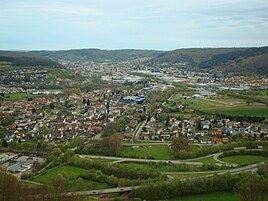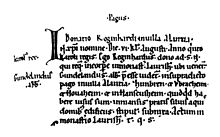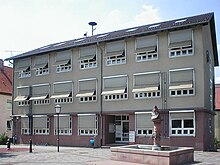Neckarelz
|
Neckarelz
City of Mosbach
|
|
|---|---|
| Coordinates: 49 ° 20 ′ 28 ″ N , 9 ° 6 ′ 20 ″ E | |
| Height : | 148 m above sea level NN |
| Residents : | 6500 |
| Incorporation : | April 15, 1975 |
| Postal code : | 74821 |
| Area code : | 06261 |
|
The mouth of the Elz (Neckarelz in front, Mosbach in the back)
|
|
Neckarelz is a district of the large district town of Mosbach in the Neckar-Odenwald district in Baden-Württemberg . Around 6,500 people live in this district, which is the largest after the city center.
geography
The Neckarelz district is located in northern Baden-Württemberg in the border area between Odenwald and Kraichgau at the confluence of the Elz and Neckar rivers . On the other bank of the Neckar are Hochhausen and Obrigheim . Down the Neckar, Diedesheim joins and up the valley in the Elztal lies Mosbach , with which Neckarelz has grown together through the expansion of residential and commercial areas in the late 20th century.
history
Early days
Neolithic , Bronze and Iron Age finds indicate an early and dense settlement of the Neckarelzer area. From the second half of the first century AD to the beginning of the second half of the third century, the presence of the Romans has been proven - also through various individual finds.
middle Ages
Finally, a row of graves proves the Alemannic presence of the place in the 6th and 7th centuries.
Neckarelz was first mentioned in a document as Alantia in the Lorsch Codex in 773 .
In 1316 the Lords of Weinsberg and in 1350 the Knights of Hirschhorn also became owners of parts of the place. Between 1377 and 1395 they repeatedly transferred parts of the district to the Count Palatinate near Rhine until 1412, when the last part was transferred to the Count Palatine von Mosbach Neckarelz, it fell completely to the Palatinate. Since 1499 the place was then under the Electoral Palatinate . The period of the Electoral Palatinate of Neckarelz, which began over three hundred years ago, is still reflected today in the local coat of arms.
Modern times
In 1556 the Reformation entered Neckarelz.
During the Thirty Years' War the place was repeatedly ravaged by troops marching through. In autumn 1621 Ernst von Mansfeld set up his headquarters in Neckarelz, and Tilly's troops followed in autumn 1621 . In the 1630s, the Swedes finally devastated the Neckar valley. During the War of the Palatinate Succession , the place was repeatedly affected by troop movements and billeting, as well as in the coalition wars .
In 1806 Neckarelz came under the sovereignty of the Grand Duchy of Baden . The town was both actively involved in the Baden Revolution (1848) and affected by the consequences of Prussian billeting (1849).
In addition to agriculture and forestry, the residents of Neckarelz also found their livelihood in the Eisenhammer mentioned in 1702 and in the brickworks founded in 1786. Neckarelz reached the industrial revolution in 1890 with the establishment of the Georg Röth iron foundry , after the place had already been connected to modern transport infrastructure in 1878 by the introduction of chain shipping on the Neckar and in 1879 by the commissioning of the Neckar Valley Railway . In 1895 another foundry was added with the iron foundry Ditté and Sons . Both foundries survived the two world wars, after the Second World War two more foundries and various steel and mechanical engineering companies settled.
The Neckarelz concentration camp , a satellite camp of the Natzweiler-Struthof concentration camp, was located in Neckarelz from 1944 to 1945 . The prisoners were supposed to cut manufacturing rooms into the plaster tunnels. They were initially trapped in school. In the end, almost 10,000 people worked in the underground bomber aircraft engine factory in Obrigheim, many of them prisoners of various kinds. Among them the 5,000 concentration camp inmates formed the main group. 900 could still be liberated in April 1945.
In the course of the municipal reform, Neckarelz was incorporated into Mosbach on April 15, 1975. This decision caused great resentment among the population, as they rejected the integration with a large majority.
Since around the 1960s, the place has experienced the structural change that is also noticeable in many other places in the area. Most of the industrial operations were given up, often as a result of being taken over by larger companies, as in the case of the Ditté iron foundry, which was taken over by the Heilbronn company Mehne , which has since been absorbed by Kardex . The city of Mosbach, especially under Mayor Werner Tarun (in office from 1954 to 1974), tried very hard to establish the settlement of industry and commerce as well as a central function of the city for the surrounding areas, so that the gradual decline of industry in Neckarelz Thousands of new jobs created in Mosbach were compensated. After Neckarelz was incorporated, Mosbach was quickly raised to the status of a major district town .
population
Population development
- Development of the population

religion
Neckarelz was a predominantly Protestant village until after the Second World War . The influx of Catholic refugees made it necessary to build a new Catholic church, as the temple house was no longer sufficient for the parish. The Catholic parish belongs to the Elz-Neckar pastoral care unit and is also based in the Neckarelz district.
coat of arms
The blazon of the former municipal coat of arms of Neckarelz reads: In a divided shield above, diagonally roughened in silver and blue, below in red a golden trout. The rhombuses of the Electoral Palatinate indicate that it was once part of the Electoral Palatinate, while the trout stands for the fishing that has long been practiced in Neckarelz.
Culture and sights
Buildings and monuments
- The temple house is a former Johanniter castle from the 12th / 13th centuries. Century, which was used as a Catholic parish church from the early 18th century until the construction of St. Mary's Church in 1955.
- The Protestant St. Martin's Church , renovated in 1773 , the rectory and the Brother Klaus educational center round off the ensemble near the temple house. There is a memorial to Auguste Pattberg , who lived in this house for a while, on the garden wall of the Bildungshaus .
- The town hall is a functional building built in 1964, renovated in 1994, with a town hall fountain from 1990.
- Several historical half-timbered buildings have been preserved in the village, including the old post office and the Alfeldsche Haus .
education
Neckarelz has a primary school ( Clemens-Brentano- School) and a high school ( Auguste-Pattberg-Gymnasium ), which is one of the 44 model schools in Baden-Württemberg that offer a G9 train. There are also several kindergartens in the district. Until 2014 there was also a secondary school ( Auguste-Pattberg- Hauptschule ) in the same building as the Auguste-Pattberg-Gymnasium .
Museums and memorials
The "Heimatverein Neckarelz-Diedesheim" has been running a small museum since 1999. The permanent exhibition is dedicated to the past of the site, a separate room is available for temporary exhibitions.
Furthermore, a concentration camp memorial with a museum, which is housed in an extension of the Clemens Brentano School, commemorates the Neckarelz concentration camp. A factory for aircraft engines was built here in a gypsum tunnel on the opposite bank of the Neckar between 1944 and 1945.
Sports
SpVgg Neckarelz , founded in 1921, is the largest sports club in Neckarelz. The club consists of the departments of ball sports, soccer, gymnastics, handball, youth soccer, children's gymnastics, wheelchair sports, table tennis and sports badges.
On June 27, 2009, SpVgg Neckarelz was drawn in the first main round of the DFB Cup to the 14-time cup winners FC Bayern Munich . The game was played on August 2nd in the Rhein-Neckar-Arena in Sinsheim . Neckarelz lost 1: 3.
Economy and Infrastructure
Authorities
In the Neckarelz district there is an administrative office for the large district town of Mosbach. There is also a branch of the Bundeswehr Service Center in Bruchsal, and until 2011 the Bundeswehr also maintained a barracks (Neckartal barracks). From 2016 , a training and training area owned by the Federal Association of Rescue Dogs was built on their premises under the name TCRH Training Center Retten und Helfen , where fire brigades, THW, rescue services, aid organizations and authorities can practice operations in major incidents.
Established businesses
The Mosbach industrial park and a shopping center are located in the Neckarelz district.
traffic
The Neckarelz district is an important railway junction. In Neckarelz, the Neckarelz – Osterburken line branches off from the Neckar Valley Railway Heidelberg – Bad Friedrichshall. The S1 and S2 lines of the RheinNeckar S-Bahn serve the Homburg (Saar) –Kaiserslautern – Mannheim – Heidelberg – Mosbach – Osterburken route. Neckarelz train station is served on weekdays from 4:00 a.m. to 1:30 a.m., on weekends almost around the clock. Since December 2014 the Stadtbahn Heilbronn tram line S41 has been running to Mosbach (Baden) via Neckarelz. There is also a regional express connection to Mannheim or Heilbronn every two hours . In Neckarelz there is a travel center, signal box, S-Bahn parking space and a maintenance facility for Deutsche Bahn AG. At the end of 1867, a weighbridge was built in the station .
The bus Rhein-Neckar GmbH also operates in Neckarelz a retail outlet and a bus depot.
At the so-called Mosbacher Kreuz , which is on the banks of the Neckar near the Neckarelz district, the federal roads 27 , 37 and 292 meet.
A connection by ship is also available, as the district is located directly on the Neckar and has a port.
Personalities
Individual evidence
- ↑ a b c d Fritz Liebig: Neckarelz. Diedesheim. Two villages on the path of destiny of our people. Neckarelz and Diedesheim municipalities 1972.
- ↑ Minst, Karl Josef [transl.]: Lorscher Codex (Volume 4), Certificate 2614 July 27, 773 - Reg. 935. In: Heidelberger historical stocks - digital. Heidelberg University Library, p. 184 , accessed on April 10, 2015 .
- ^ Federal Statistical Office (ed.): Historical municipality directory for the Federal Republic of Germany. Name, border and key number changes in municipalities, counties and administrative districts from May 27, 1970 to December 31, 1982 . W. Kohlhammer, Stuttgart / Mainz 1983, ISBN 3-17-003263-1 , p. 485 .
- ^ Dagmar Klahr: G9 model schools . April 10, 2015 ( km-bw.de [accessed March 18, 2018]).
- ↑ MGS headmaster: "The Werkrealschule is not a dead end" . ( rnz.de [accessed on March 18, 2018]).
- ↑ Heimatverein Neckarelz and Heimatmuseum on the website of the Heimatverein
- ↑ Heiko Schattauer: Neckarelz receives “Disaster City” based on the Texan model. Rhein-Neckar-Zeitung, March 17, 2017, accessed on June 13, 2018.
- ↑ Perspectives of the Heilbronn Stadtbahn ( Memento from September 10, 2008 in the Internet Archive )
- ^ Jürgen Heß, Herbert Hoffmann, Siegbert Luksch: No. 5: Looking back at 150 years of the Meckesheim railway location: 11: Chronology. (PDF; 568 KiB) November 29, 2013, accessed January 2017 .










